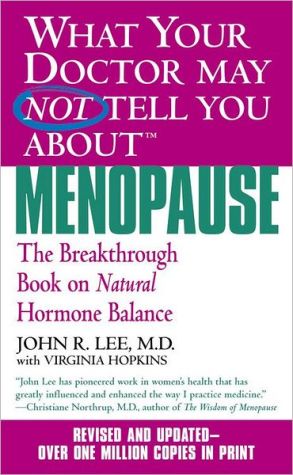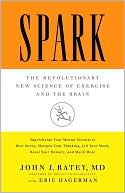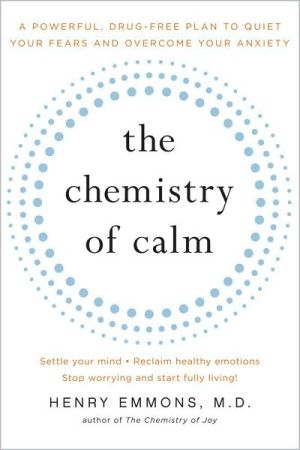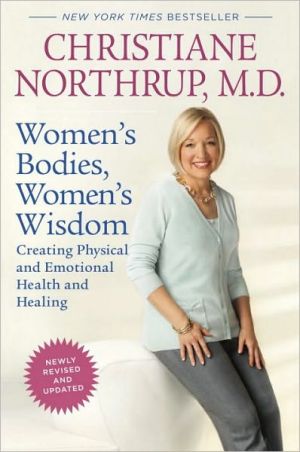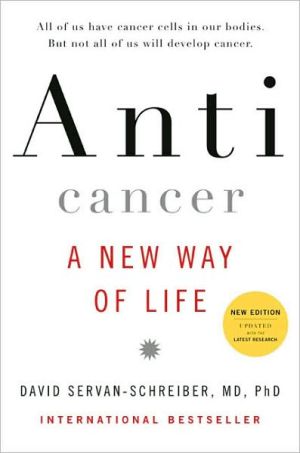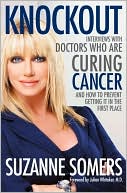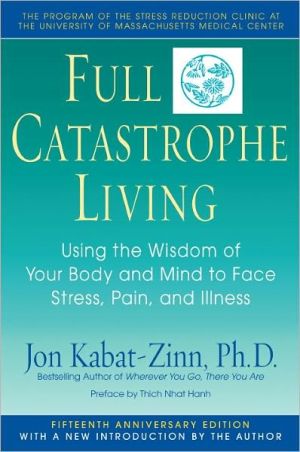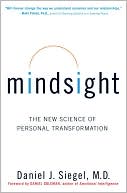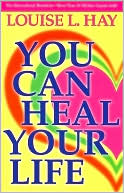What Your Doctor May Not Tell You about Menopause: The Breakthrough Book on Natural Hormone Balance
Over a decade ago, Dr. John Lee first published his startling conclusions about conventional hormone replacement therapy (HRT): synthetic hormones don't work as predicted and, worse, they pose a health threat to women. His findings touched off a storm of controversy. But years later, research has proved him right. Now millions of women concerned about aging must decide whether or not to undergo synthetic hormone replacement therapy -- and suffer its side effects and increased health risks....
Search in google:
Women considering hormone replacement therapy (HRT) for menopause symptoms and health benefits should read this controversial, provocative book first. "Advertising and research dollars are spent trying to convince women that estrogen will cure everything from heart disease to Alzheimer's," writes John R. Lee, M.D., "but there is scant evidence for any of these claims and reams of evidence that synthetic estrogens are highly toxic and carcinogenic." Lee has studied the research and concludes that estrogen is not the magic bullet for protection against heart disease and osteoporosis, nor does it retard aging. Natural progesterone, instead, puts postmenopausal women's hormones in balance, says Lee. He cites study after study that indicates that natural progesterone, obtained in cream form, delivers what the usual HRT only promises. "Menopause as a disease has been largely fabricated by physicians and the pharmaceutical industry," says this leader of a "quiet but powerful revolution" regarding HRT. <I>What Your Doctor May Not Tell You About Menopause</I> covers the benefits of natural progesterone, the history and politics of the medical and drug establishment, the biochemistry and dynamics of hormones and how they get out of balance, and how to prevent hormone imbalance and stay healthy. Lee empowers you to ask hard questions of your doctor.
What Your Doctor May Not Tell You About Menopause (Revised & Updated\ The Breakthrough Book on Natural Hormone Balance \ \ By John R. Lee Virginia Hopkins \ Warner Books\ Copyright © 2004 John R. Lee and Virginia Hopkins\ All right reserved.\ ISBN: 0-446-61495-5 \ \ \ Chapter One\ THE CRUX OF THE MATTER: MENOPAUSAL POLITICS AND WOMEN'S HORMONE CYCLES \ Not so long ago, menopause was a word you did not say out loud in public, and you had to go to a medical library to find a book on the subject. Go into a typical bookstore these days and you'll find literally dozens of titles on menopause.\ They range from praising the wonders of estrogen and hormone replacement therapy to personal stories of the ups and downs some women experience during the "change of life," and there are now many other books written on the subject of natural hormones. What was once a taboo subject has become a mainstay of talk shows and women's magazine articles.\ Menopausal Politics\ With 30 million menopausal women in North America and some 20 million baby boomer women in menopause or on the brink of it, it's no wonder this is a major topic of discussion. What is a wonder is how we have managed to make menopause, a perfectly natural part of a woman's life cycle, into a disease. It has only just dawned on us that menstruation, pregnancy, and childbirth are not diseases; now we need to realize that menopauseis not a disease despite millions in advertising dollars spent by drug companies to convince us otherwise. The pharmaceutical companies have not failed to notice the huge population of premenopausal women in the pipeline, a financial gold mine in the making. Premarin, a form of hormone replacement therapy made from pregnant mare's urine by the Wyeth-Ayerst Company, was one of the top-selling prescription medicines in the United States until the 2002 Women's Health Initiative (WHI) study showed that PremPro (a combination of Premarin and a progestin) increased the risk of breast cancer, strokes, and gallbladder disease. Although Premarin/ PremPro generated more than $2 billion in sales in 2001 and represented 22 percent of Wyeth's pharmaceutical sales, more recently, sales of Premarin/PremPro have declined about 25 percent.\ In 1995, when I first wrote this book, I stated, "A large percentage of advertising and research dollars are spent trying to convince women that estrogen will cure everything from heart disease to Alzheimer's, but there is scant evidence for any of these claims and reams of evidence that synthetic estrogens are highly toxic and carcinogenic." Now the WHI has proven me correct on this, and many millions of women are searching for a safe alternative to PremPro. In my opinion, it's not so much the estrogens per se that are toxic and carcinogenic, it's estrogens used in excess, and with progestins instead of natural progesterone. But you will learn a lot more about this as you read further.\ The good news is that women have become guarded and skeptical about having new drugs pushed on them. After being told that DES, a hormone that was supposed to guard against miscarriages, was safe, hundreds of thousands of women discovered the hard way that it caused cancer in their children. Women were told that Valium was a safe and effective remedy for depression and anxiety, only to find out that it was addictive. Then their physicians tried to convince them that once they had reached menopause they should automatically go on hormone replacement therapy featuring synthetic estrogens and progestins, only to find it could increase their risk of deadly diseases rather than save them from the aging process. It is telling that only 10 to 15 percent of menopausal women chose to use conventional HRT despite intense pressure from doctors and the media. The real tragedy is that many thousands of women may have died or been permanently harmed because they used HRT, when the natural forms of these hormones, used wisely and in moderation, could have been, and still could be of very real benefit. In the chapters that follow, we will look more closely at how estrogen and progesterone work in a woman's body and the politics of pushing drugs to women.\ What Is Menopause?\ Strictly speaking, menopause is the cessation of menses, the end of menstrual cycles. The unpleasant "symptoms" of menopause that some women suffer, such as hot flashes, vaginal dryness, and mood swings, are peculiar to industrialized cultures and, as far as I can tell, they are virtually unknown in agrarian cultures. In native cultures menopause tends to be a cause for quiet celebration, a time when a woman has completed her childbearing years and is moving into a deeper level of self-discovery and spiritual awareness. She is becoming a wise old woman. In these cultures menopausal women are looked up to and revered. They are sought out for advice and their opinions are heavily weighed in the decision-making process of the community.\ How strange that sounds to us! We know menopause as a death knell, the end of a woman's sexuality, a descent into a dried-up and painful old age of arthritis and osteoporosis. How did this experience of menopause come to be? I believe it's a combination of poor diet, unhealthy lifestyle, environmental pollutants, cultural attitudes, the incorrect use of synthetic hormones, and advertising. But first, let's look at what happens in a woman's body as menopause approaches.\ The Rise and Fall of Hormones During the Menstrual Cycle\ In a normal menstrual cycle, every 26 to 28 days, the ovaries, which hold a woman's eggs, receive a hormonal signal from the brain that it's time to get some eggs ready to be fertilized. Anywhere from a few to a few hundred eggs begin to mature inside sacs called follicles. After 10 to 12 days one egg has moved to the outer surface of the ovary and the follicle bursts, releasing the egg into the fallopian tube for its journey to the uterus.\ As the egg is ripening in the ovary, the uterus is ripening in preparation for the possibility of growing a fetus. The uterine lining thickens and becomes engorged with blood that will nourish the growing embryo. If no fertilized egg implants itself in the uterus, it sheds its lining. This shedding is the blood of menstruation. Then the cycle begins again, with the signal from the brain telling the ovary to ripen an egg.\ Estrogen (from estrus, meaning "heat" or "fertility") is the dominant hormone for the first week or so after menstruation, stimulating the buildup of tissue and blood in the uterus as the ovarian follicles simultaneously begin their development of the egg. Around the time of ovulation, estrogen causes changes in the vaginal mucus, making it more tolerant of male penetration during sexual activity and more hospitable to sperm. At this phase in the menstrual cycle, the vaginal mucus tends to somewhat resemble uncooked egg whites. Watching for this change in mucus combined with a rise in body temperature is one of the best nonlaboratory methods for identifying the time of ovulation.\ About twelve days after the beginning of the previous menstruation, the rising estrogen level peaks and then tapers off just as the follicle matures and just before ovulation. After ovulation the now-empty follicle becomes the corpus luteum (so named because of its appearance as a small yellow body on the surface of the ovary). The corpus luteum is the site of progesterone production, which dominates the second half of the menstrual month, reaching a peak of about 20 milligrams (mg) per day.\ Progesterone production during this phase of the cycle, along with estrogen, leads to a refinement and "ripening" of tissue and blood in the uterus. Progesterone also contributes to the changes in the vaginal mucus seen at the time of ovulation. The rise of progesterone at the time of ovulation causes a rise of body temperature of about one degree Fahrenheit, a finding often used to indicate ovulation.\ If pregnancy does not occur within 10 to 12 days after ovulation, estrogen and progesterone levels fall abruptly, triggering menstruation, and the cycle begins anew. If pregnancy occurs, progesterone production increases and the shedding of the lining of the uterus is prevented, thus preserving the developing embryo. As pregnancy progresses, progesterone production is taken over by the placenta and its secretion increases gradually to levels of 300 to 400 milligrams per day during the third trimester.\ Premenopause\ A woman's hormone balance can begin to shift at anywhere from her mid-30s to her late 40s, depending on a variety of factors such as heredity, environment, how early or late she began menstruating, whether she had children and if so at what age and how many, and her lifestyle. Was she exhausted trying to juggle career and family? Was she eating junk food, caffeine, sugar, and alcohol or whole grains, fresh vegetables, and fruits? Has she taken vitamins? Has she lived in the city or country? Was she exposed to toxins in the workplace? Hormone balance is intimately connected to stress levels, nutrition, and the environmental toxins encountered daily. We will discuss all of these factors more thoroughly in the chapters to come.\ The ability of the follicles to mature an egg and release it may begin "sputtering," so to speak, a decade before actual menopause, creating menstrual cycles in which a woman does not ovulate, called anovulatory cycles. If she isn't ovulating, she isn't producing progesterone from the ovaries and she may begin experiencing menopausal symptoms such as weight gain, water retention, and mood swings.\ Menstrual cycles can continue even without the progester-one, however, so most women aren't aware that the lack of progesterone is causing their symptoms. I call this phase premenopause. I will be discussing premenopause symptoms in more detail, and have also written an entire book on the subject called What Your Doctor May Not Tell You About Premenopause. The phase right around the time of menopause, when hormones and brain signals to the ovaries are fluctuating, is called perimenopause.\ It used to be true that the majority of women began menopause in their mid-40s to early 50s. In the last generation, however, things appear to have changed. Women now may have anovulatory periods starting in their early 30s and yet do not experience cessation of periods (menopause) until their 50s. During this time, the ovaries continue to produce estrogen sufficient for regular or irregular shedding, creating what I term "estrogen dominance," which will be discussed in detail throughout the book.\ Some women may go for years with irregular cycles and slowly wind down, or may just suddenly stop menstruating one month and never menstruate again. They may be over-whelmed with unpleasant symptoms or hardly notice what has happened other than not having to worry about birth control or tampons every month. How menopause is experienced is as individual and unique as each human being.\ During the many months of anovulatory periods, estrogen production may become erratic, with surges of inappropriately high levels alternating with irregular low levels. Periods of vaginal bleeding may become erratic, some much heavier than others. When estrogen surges, women undergoing these changes may notice breast swelling and tenderness, mood swings, sleep disturbance, water retention, and a tendency to put on weight. These may be the symptoms of estrogen dominance caused mainly by lack of ovulation and thereby lack of progesterone while their estrogen levels are still in the "normal" range. Their doctors may check their estradiol levels and their follicle stimulating hormone (FSH) and luteinizing hormone (LH) levels, but rarely does it dawn on them that their patients' progesterone levels are too low. In taking the usual blood tests, the doctor may find the estrogen normal that day or even a bit on the low side and FSH levels a bit too high. On another day the estrogen might be elevated and FSH levels normal. If the former is found, the doctor may even prescribe some estrogen on the theory that the patient is nearing true menopause. The woman usually finds that this does not help her and often makes things worse.\ More often, the doctor ascribes her complaints to emotional causes or simply some defect of Mother Nature that women must endure. In later chapters, I will discuss this phenomenon in more detail. For the present, we will merely say that a rising percentage of women are experiencing premenopausal woes that are related to their hormones. The details concerning environmental toxins, nutritional factors, stress, adrenal hormones, exercise, and weight will be found in the chapters ahead.\ (Continues...)\ \ \ \ \ Excerpted from What Your Doctor May Not Tell You About Menopause (Revised & Updated by John R. Lee Virginia Hopkins Copyright © 2004 by John R. Lee and Virginia Hopkins. Excerpted by permission.\ All rights reserved. No part of this excerpt may be reproduced or reprinted without permission in writing from the publisher.\ Excerpts are provided by Dial-A-Book Inc. solely for the personal use of visitors to this web site. \ \
ForewordxiIntroductionxviiPart IThe Inner Workings of Hormone Balance1Chapter 1The Crux of the Matter: Menopausal Politics and Women's Hormone Cycles3Menopausal Politics3What Is Menopause?5The Rise and Fall of Hormones During the Menstrual Cycle5Premenopause7Chapter 2The Dance of the Steroids10The Cast of Major Players11Choreographing the Dance13The Journey Along the Steroid Hormone Pathway14The Dance of the Steroids15Four Movements: The Flow of Steroids in Our Bodies16Chapter 3The History of Hormone Replacement Therapy and the Estrogen Myth19Menopause Becomes a Disease20The Truth Behind the Hoopla22Perpetuating the Estrogen Myth26The HRT Chickens Come Home to Roost30Chapter 4What Is Estrogen?35How and Where Estrogens Are Made and Used in the Body38Estrogen and Cell Division39How Estrogen Affects a Woman's Body40Estrogen Dominance41The Myth of Estrogen in Hormone Replacement Therapy43What Are "Normal" Estrogen Levels?46Chapter 5Hormone Balance, Xenobiotics, and Future Generations50Turning on the Hormone Switch51The Canary in the Coal Mine?53The Impact on Future Generations54Safe Living in a Sea of Estrogens56Pesticides and Plastics58Solvents59Xenoestrogens and Future Generations63If You Want to Know More65Chapter 6What Is Natural Progesterone?67The Discovery and Use of Progesterone68Exactly What Is Progesterone?72The Cycle of Progesterone Production75Progesterone and Procreation75How Progesterone Affects the Body77Progesterone and Steroid Synthesis77Progesterone and the Brain79Progesterone and Sex Drive81Progesterone in Men83Chapter 7The Dramatic Difference Between Progesterone and Progestins85The Difference between Synthetic Drugs and Natural Compounds87What Is a Progestin?90Progestins Gave Birth to the Sexual Revolution95Chapter 8Sex Hormones and the Brain98The Basics of Brain Communication98How the Inner and Outer Brains Regulate the Body100Estrogen and the Brain101Progesterone and the Brain103Progesterone and Fetal Brain Development103Progesterone and Brain Injuries104Progesterone and the Elderly105Progesterone and Libido105Postpartum Blues106Progesterone and Sleep Patterns107Chapter 9What Are Androgens?108DHEA111Testosterone112Androstenedione113Chapter 10Hormone Balance and the Menstrual Cycle115The Rise and Fall of Hormone Levels116Anovulatory Cycles120Part IIHormone Balance and Illness123Chapter 11Progesterone and Menopause Symptoms125The Mystery of Menopause127A Brief Look at Premenopause128Falling Estrogen and Progesterone, Rising GnRH, and Hot Flashes128Progesterone Deficiency130Menopause and Estrogen131Androgens and Menopause132What Can Be Done for Menopausal Symptoms?134Chapter 12Hormone Balance and the Adrenal and Thyroid Glands135Premenopause and Stress135Follicle Burnout138Estrogen Excess139The Adrenal Glands141The Adrenal Cortex142Progesterone and Thyroid Hormone151Chapter 13Hormone Balance, Nutrition, and Osteoporosis154Debunking the Osteoporosis Myths155What Is Osteoporosis?156A Bit About How Bones Are Built156Osteoporosis and Estrogen158Osteoporosis and Progesterone162Other Osteoporosis Treatments171Keeping Your Bones Strong174How Bones Are Depleted183What Your Doctor May Not Know About Bone Density Measurement (BMD)192Chapter 14Women and Cardiovascular Disease198Estrogen and Heart Disease199Progesterone and Heart Disease200Only Half of Heart Attack Deaths in Women Are Caused by Blocked Arteries200Insulin and Heart Disease202What About Cholesterol?207High Blood Pressure208Iron Overload209Homocysteine212C-Reactive Protein (CRP)214Nutrition and Lifestyle214What About Aspirin?216Strokes and Hormone Balance218The Bottom Line223Chapter 15Hormone Balance and Cancer224Reestablishing Cellular Communication225How Cancer Develops226Estrogen Stimulates Cell Growth228The Cancer-Protective Benefits of Progesterone234Hormone Receptors in Breast Cancer239What About Mammograms?240Tamoxifen and Aromatase Inhibitors244Endometrial Cancer245Transcultural Factors in Breast and Uterine Cancer248Chapter 16Getting Off Conventional HRT and on to Natural Hormones251Questions and Answers About Natural Hormone Replacement Therapy252Chapter 17Natural Hormone Balance and Pelvic Disorders255Vaginitis256Pelvic Inflammatory Disease (PID)257Ovarian Cysts and Mittelschmerz258Endometriosis259Fibroids261Endometrial Cancer263Hysterectomy263Staying Naturally Healthy265Chapter 18Hormone Balance and Other Common Health Problems266Premenstrual Syndrome (PMS)267Hypothyroidism (Low Thyroid)271Fibrocystic Breasts277Migraine Headaches278Skin Problems (Acne, Seborrhea, Rosacea, Psoriasis, and Keratoses)279Candida281Allergies282Arthritis283Autoimmune Disorders284Urinary Tract Problems284Gallbladder Disease and Bile Flow288Part IIICreating and Maintaining Hormone Balance293Chapter 19How to Use Progesterone Supplementation295Types of Progesterone Supplementation295Testing Hormone Levels299Not All "Wild Yam Extract" Is Progesterone301How and When to Use Natural Progesterone303Possible Side Effects of Progesterone304How to Get the Most Out of Progesterone Cream308When During the Month to Use Progesterone Cream309Where to Find Natural Progesterone320A Final Reminder321Chapter 20How to Use Estrogen, DHEA, Pregnenolone, the Corticosteroids, Testosterone, and Androstenedione323Estrogen324DHEA325Pregnenolone326The Corticosteroids327Testosterone329Androstenedione331Chapter 21Nutrition for Healthy Hormones332Refined Carbohydrates333Excess Calories, Not Just Excess Fat334Good Fats and Bad Fats335Whole Foods Are Best338Eat Organic Foods Whenever Possible341Is Vegetarianism Protective?341Opt for Free-Range Meats, Eggs, and Poultry342Are Dairy Foods Right for You?343Eat Your Phytochemicals344Eat More Fiber345Drink Plenty of Clean Water346Take Your Multivitamins347Minerals350Your Ideal Diet353Get Some Exercise354How Are Your Adrenal Glands Working?355Digestion356Herbs for Hormone Balance360Chapter 22Commonly Asked Questions About Using Natural Progesterone364Glossary373Resources377Recommended Reading389References393AppendixThe Structure of Steroid Hormones425Index431
